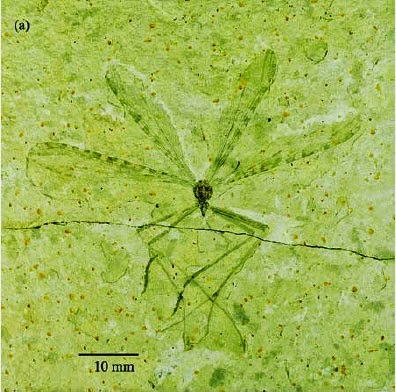Hangingflies, Bittacidae, are large members of the Scorpionfly
order, Mecoptera, which resemble the more widespread Craneflies (members of the
True Fly order, Diptera) both in morphology and lifestyle, although the two
groups are easily separated, as Hangingflies have two pairs of wings and
Craneflies only one. Hangingflies uncommon today, with about 270 species known
worldwide, but are thought to have been far more abundant and diverse in the
Jurassic, before Flowering Plants and associated Insects came to dominate
terrestrial ecosystems.
In a paper published in the journal ZooKeys on 19 December 2014,
Sulin Liu, Chungkun Shih and Dong Ren of the College of Life Sciences at
Capital Normal University describe four new species of Hangingflies from the
Middle Jurassic Jiulongshan Formation of Inner Mongolia. The Jiulongshan Formation
comprises a series of grey tuffaceous sandstones and sandy mudstones which has
produced a large number of extremely detailed fossils of a wide variety of
insects, including Moths, Hangingflies, Wasps, True Flies, Lacewings and many
extinct groups.
The first new species described is placed in the genus Mongolbittacus, which to date has been
known only from a single species from the Jiulongshan Formation, and given the
specific name speciosus meaning ‘showy’. This species is described from a
single male specimen, preserved in lateral view as part and counterpart from
within a split block. This specimen is 8.8 mm in length and preserved with all
four wings held open and separated from one-another.
Mongolbittacus speciosus, photo of part. Scale bar is 3 mm. Liu et al. (2014).
The second new species is also placed in the genus Mongolbittacus, and is given the
specific name oligophlebius, meaning
‘few veins’ in reference to the low number of crossveins on the the
wings. This species is described from two specimens, both preserved as part and
counterpart from split blocks. The first is only partially exposed, with only
one forewing and the forepart of the body visible, the second is preserved with
the limbs folded over the body.
Mongolbittacus oligophlebius, first specimen, photo of part. Scale bar is 3 mm. Liu et al. (2014).
The third specimen is placed in the genus Exilibittacus, which is also known to date from a single species
from the Jiulongshan Formation, and given the specific name foliaceus, meaning ‘leafshaped’, in
reference to the shape of the wings. This species is described from a single
female specimen, 12.9 mm in length, preserved in dorsal view on a split block.
Exilibittacus foliaceus, female specimen in dorsal view. Scale bar is 3 mm. Liu et al. (2014).
The final new species is also placed in the genus Exilibittacus, and is given the specific
name plagioneurus, meaning ‘oblique
veined’, in reference to the oblique crossveins on its wings. The species is
described from a single female specimen, preserved in dorsal view as part and
counterpart from a split block.
Exilibittacus plagioneurus, dorsal view of part. Scale bar is 3 mm. Liu et al. (2014).
See also…
Hangingflies are long-legged Scorpionflies (Mecoptera), a group of
insects related to the True Flies. Scorpionflies get their name from the
reproductive organs of the males of some species, which resemble the
tails of Scorpions. Despite this fierce appearance most species are
harmless herbivores, though it is thought that fleas are highly...
Earwigflies (Meropeidae) are a small group within the Mecoptera
(Scorpionflies), known only from four fossil and two modern species.
Three of the fossil species are from the Triassic of Kyrgyzstan, and the
fourth from the Jurassic of Siberia, while the two modern species, Merope tuber and Austromerope poultoni are from North America and Australia respectively. Little is known of
the biology of these Insects, the larvae having never...
The Scorpionflies (Mecoptera) are a group of insects related to the True
Flies. They get their name from the reproductive organs of the males of
some species, which resemble the tails of Scorpions. Despite this
fierce appearance most species are harmless...
Follow Sciency Thoughts on Facebook.







